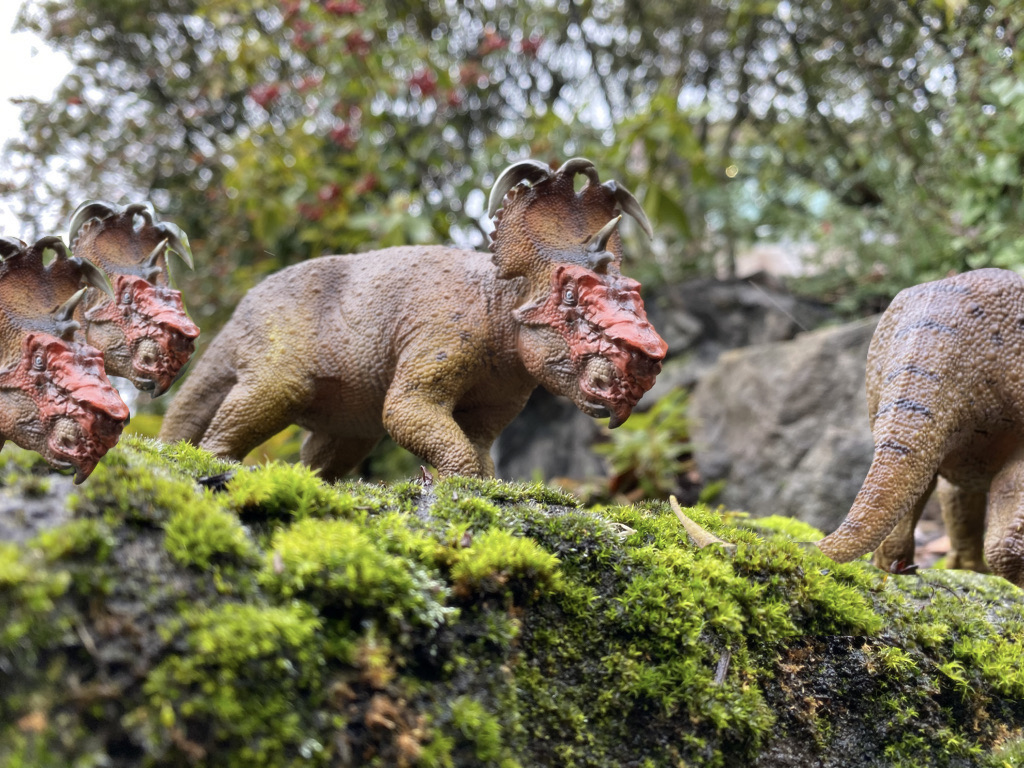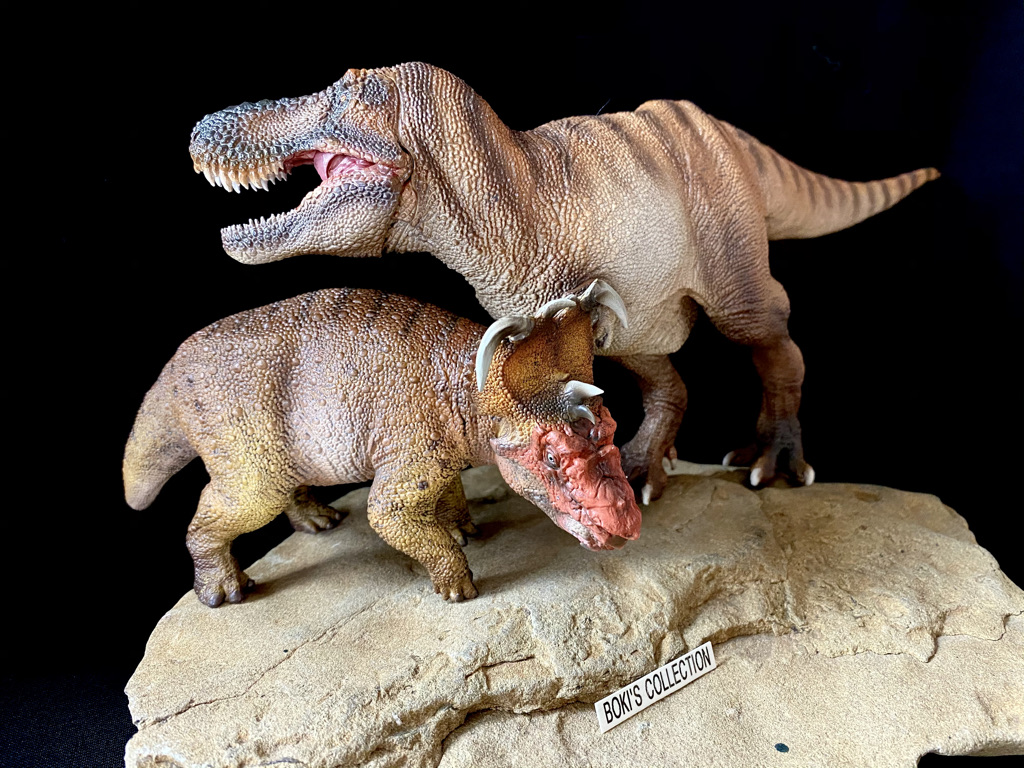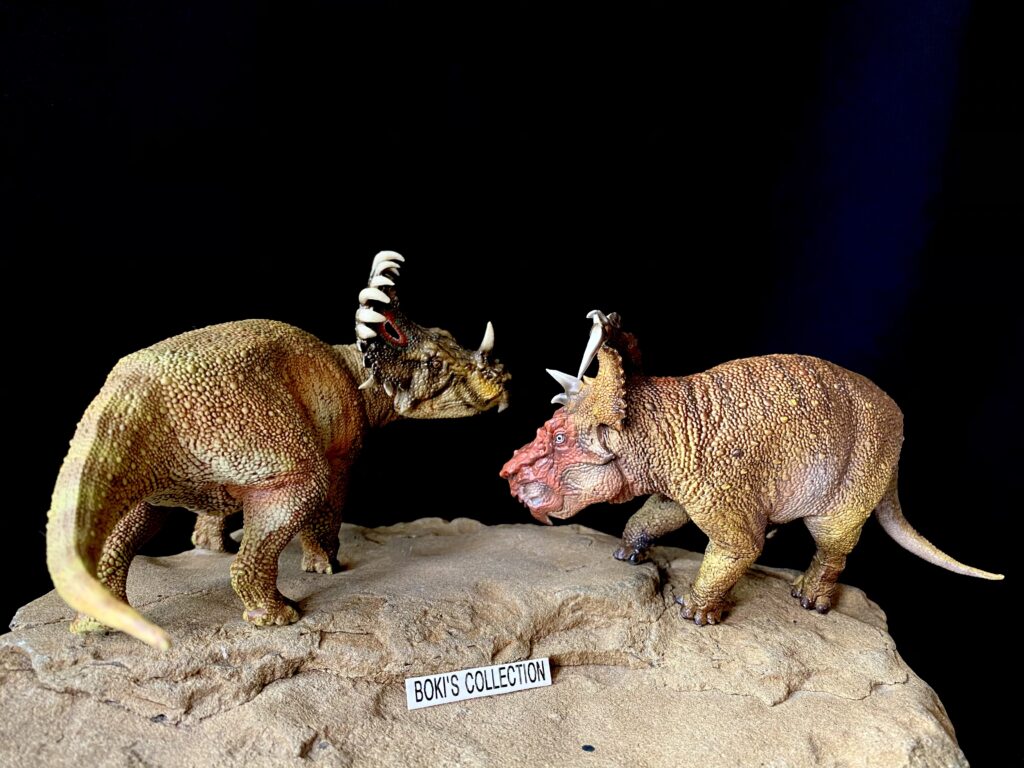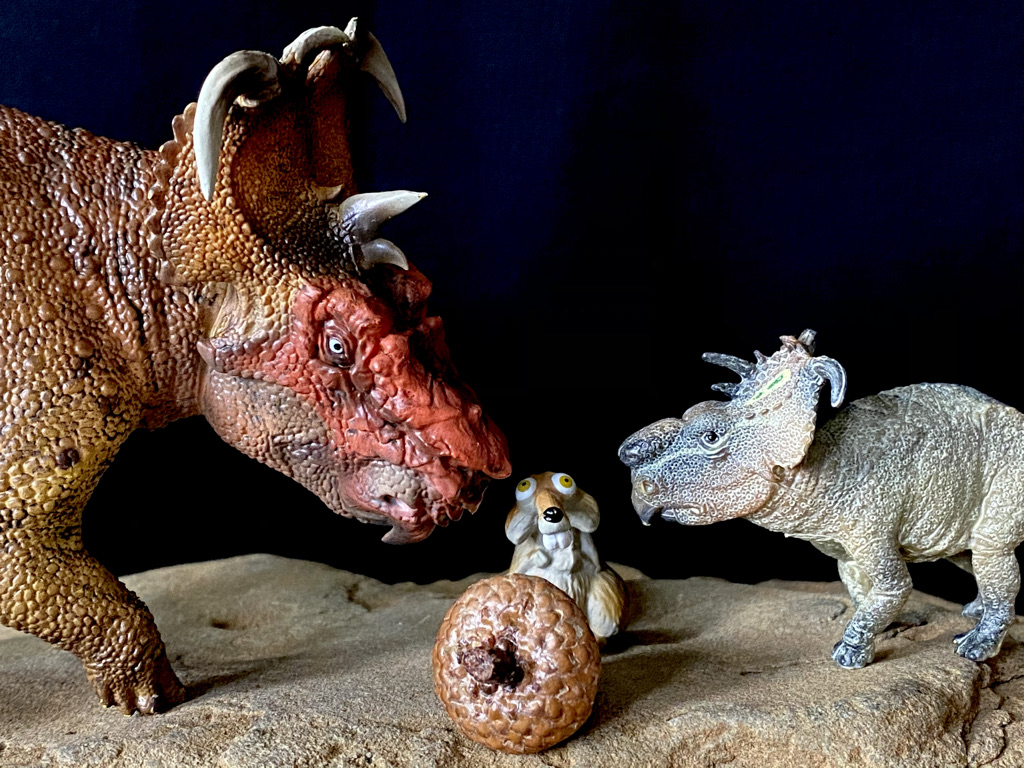The rainy season is in full swing and out on the plains, herds of animals are gathering for their migration. Their path is cut by a river that, just a few months ago, was shallow and easy to cross. As the rain gather strength, so too are the numbers of animals coming in from different corners. High above, the clouds darken as the wind started to make its full strength known sending pterosaurs to seek safe shelter below the cloud line as the storm approaches.

The once parched crackly ground of summer is now muddy and slippery and as the herds pack closer towards the riverbank, their combined weight causes cliffs to collapse. The air is filled with various calls as each animal tries to maintain contact with its herd as they wait for the first brave one to take the plunge. The once placid river continues to rise and is now an angry torrent of water rushing down, causing destruction along its path. And as if on queue, the sky unleashes frightening lightning and deafening thunders that echoes far across the plains panicking the herds.

In unison, the panicked herds of animals make the faithful decision to jump into the raging river to try to get across,; like falling dominos, animals fall from high above the riverbanks creating big splashes as their large bodies hit the water below. Many of these animals will not make it safely across; the combination of strong currents, chaos, slippery banks, and low visibility working against them. Soon, the river becomes choked with panicked and dead animals. The dead will be swept downriver, some will be caught in smaller channels where they will await their final fate.

The scene that played out sounds like it was straight out of East Africa’s Serengeti, but this took place millions of years ago during the late Cretaceous in what would be known today as North America and Canada. Instead of Wildebeest and Zebra herds, there were dinosaurs such as various species of ceratopsians and hadrosaurs that embarked in epic migrations. The huge ceratopsian Pachyrhinosaurus was one of these species that made these perilous journeys.

Pachyrhinosaurus (meaning “thick-nosed lizard”) is a genus of centrosaurine ceratopsid from the late Cretaceous and is one of the largest and most impressive. It also is one of the more familiar ceratopsians, having found fame in movies, documentaries, and even cameo in the star-maker JP franchise. It’s starring role in the Walking with Dinosaur movie helped catapulting it as an instant favorite, rivaling only Triceratops among the various ceratopsians to have reached that level of fame. It surely ranks as one of the best represented ceratopsians in the toy world as brand such as CollectA, Safari, Battat, Papo, Hasbro, SEGA,Matell, and of course the BoTM series all added this genus to their line. Today, we take a look at the newest, and one of the most impressive, version from PNSO.

PNSO has surprised everyone this year when they released a whole slew of new and exciting figures one right after the other. These new PVC toy figures are some of the most exquisite figures we have ever seen and has elevated PNSO to a whole new league of their own. The scale of these new figures vary but are typically around the 1:30-1:35 vacinity. This new, larger Pachyrhinosaurus figure measure around 7″ inches long (straightened out) and stand 3″ inches tall.
It is part of their medium size range. Almost all of PNSO figures are given a name, and our Pachyrhinosaurus friend is named Brain and he is #30 in the series (different name from the mini version).

The most distinctive feature of Pachyrhinosaurus is the large bony growth called boss that is present on the top of its snout where in other ceratopsian a nasal horn would be. There are three recognized species of Pachyrhinosaurus each hailing from different formation and age. The first and oldest is P.lakustai (existed 73.5 – 72.5 Ma ago) from the Wapiti Formation in Canada, the middle P. canadensis (existed 71.5-71 Ma ago) from the lower Horse Shoe Canyon formation in Western Canada, and the youngest species P. perotorum (existed 70-69 Ma ago) from the Prince Creek Formation of Alaska. Each of the different species has similarities as well as distinct differences in the size and shape of their boss as well as horns.

The distinctive nose boss varies between the three species in shape and size, with P. canadensis and P. perotorum being the most similar to one another. In addition to the unique boss, prominent horns also are present and grew from the frill although they are not as long as those seen in other members of the centrosaurine tribe. The frill has several small horn ornaments as well as two small curved and backward pointed horns, in addition, there is also a narrow boss/ridge over the eyes that in some species grew almost connected or close to the nasal boss.

Looking at the head of this figure it looks like this could be P. Lakustai. The boss has a slight raised but otherwise is very flat, flatter than the more raised look that we are used to seeing. There are small “points” on the upper part of the boss in addition to the many groves and bumps that adorn it. The nasal boss almost connects with the eye boss with only a small gap in between them. Big scales or growth is seen on the snout and on the tip, we see a trio of pointed growth just above the upper beak.

The nose is nicely sculpted and is ringed with large scales, the same can be seen around the eyes and cheek area of the head. The scales are very detailed and vary in sizes with the smaller ones around skin folds. The mouth is closed and you can see the strong and pointed “parrot-like” upper beak hook over the lower one which is mostly hidden.
The two pairs of horns on the top of the shield are nicely done and you can even see something like a swirl on the larger outer ones as it points downwards. The two smaller top ones are so close to each other that they fused together forming a heart-shaped in the center. The trio of horns on the center of the shield or forehead are also nicely sculpted; the short lower one points downwards, while the largest center one and the small top one both pint straight forward. All the horns are solid and very pointy, so if you have young kids in the household, better keep the figure out of reach as there is a real danger of injury from being punctured.

The amazing thing about the horns are how they are painted. We often see horns and spikes plainly painted one solid color usually black or gray. PNSO have given these horns a lighter gray color with darker colors on the the base that slowly transition to lighter. This gradual two-tone transition really captures the realism of what horns (or fingernails) looks like.

The body is nicely proportioned and very robust as it should be. The figure is posed in a semi-active stance with its head lowered and tilted to on side. The front legs are slightly bent as if in the act of raising it. The back legs are planted firmly on the ground and are slightly splayed adding some sense of movement. All of the legs are sculpted with lots of muscle definitions and there are plenty of subtle skin fold as well on the areas you would expect to see them. The feet are accurate and if you look under, you will delicate little details on the pads. The tail is about the right length and thickness as far as I know and is swayed to the left.

The body is covered in lots of scales ranging from small (most of the body and back) to larger ( belly area) with bigger round osteoderms mixed in. The result is a nice range of texture that has a beautiful and believable flow as they follow the muscle and skin folds. The scales on the head and shield I find particularly impressive since they are so small in size yet very detailed and visible.
Now to the colors. As you can see, the main body color is brown. The head is where we see a splash of bright colors: orange-red dominate the face and snout like a mask as it follows the outline of the upper part of the head.

Mixed in are hints of yellow as well as dark brown on top of the nasal boss and around the eyes.Speaking of eyes, the color is blueish white that contrast nicely with the surrounding orange-red and brown. On the frill, we see a gradual transition of the dark brown radiating to a yellow-orange as it reaches the center of the frill before transitioning again to the dark brown as it reaches the edges.

The body is a tapestry of various shades of brown, the back is the darkest but is given a light brown wash that really bring out the details. There is also yellow, white, and orange mixed in that really is very complex to even try to describe. The underbelly is light yellow in color and highlighted with a flush of pinkish-orange on the throat, underarm, and tail base area.This multi-layers of colors really give the figure depth that is very pleasing; often figure are given one layer of paint that makes them look flat and artificial, but PNSO has perfected the layering technique of colors that really brings their models to life.

The transition of these colors as well and the blending is so seamless that it really elevates most PNSO figures to a whole new level.Dark brown stripes adorn the back that starts from the neck and runs all the way down the tail. The tip of the tail is painted yellow which add another striking spot of color. Overall, the design and color choices on the figure is beautiful and appropriate for an animal of this size.

The fauna community assemblage that lived alongside Pachyrhino varied depending on which part of its known range. But one thing is certain, Pachyrhinosaurus lived in an environment that hosted a rich and diverse fauna including other ceratopsians such as Anchiceratops, arrhinoceratops, Eotriceratops, and Montanoceratops as well as the iconic hadrosaurs Edmontosaurus, Hypacrosaurus, and Saurolophus, the tyrannosaurid Albertasaurus and possibly a species of Daspletosaurus that ruled the land as the apex predators. Other less famous dinosaur also shared the land including the nodosaur Edmontonia as well as various species of smaller theropods, fishes, and amphibians.

The catastrophic event that would claim and preserved hundreds of individual is based on similar bones beds fond that are associated with other ceratopsians such as Centrosaurus and Styracosaurus. One explanation for such high concentration of bones of one species in one area is that the animals were congregating, perhaps during a migration and got caught by a flood as they tried to cross a river. Evidence also suggest that pachyrhinosaurus band together in mixed age and sex herd explaining the different sizes and horn shapes.This drama plaid out for millions of years and still does to this day in certain parts of the world.

No doubt that Pachyrhinosaurus will continues its meteoric rise to fame and that we will see more of it from other brands. For now, this is for me the best figure of it out there. The sculpting and exquisite details and coloring is way beyond those seen in other figures from any of the major brands at this time. For a ceratopsian fan like me, this and others from PNSO is truly exciting and worth the extra few dollars ( they are currently averaging around $22-25 each). The thought of future ceratopsian releases from PNSO is exciting and I hope that more species will be added in the near future.

Well that concludes this review. As always, thank you all for reading and I hope that you enjoyed it. Until we meet again, please continue to stay safe and healthy. Cheers!
Disclaimer: links to Ebay and Amazon on the DinoToyBlog are affiliate links, so we make a small commission if you use them. Thanks for supporting us!





Reminds me of a muscovy duck the way the boss is covered with redd knobby growths.
Yes, you are so right.
Amazing review, thanks for sharing. I am really looking forward to getting this figure, but I saw in another review that the gap between the boss above the eyes and the nasal boss is too narrow. Should I worry about this or can I consider it as an acceptable normal variant? I would appreciate any feedback from our ceratosian experts. Thanks.
Hello, if you really like the figure, I say get it. Pachyrhino like many animals show high variations on these facial features. If I were you, I wouldn’t be too worried about it.
Magnificent figure the PNSO pachyrhinosaurus is with the sinoceratops the best figure of ceratopsids that are not PNSO triceratops to date.
Magnificent Bokisaurus photographs!
You are a very observant reviewer, Bokisaurus! This was a good read, and I enjoyed the initial scene by the river. I think you are spot on about PNSO’s skill in creating layers of colour and that sets them apart for me from their competitors. Some super photos – I thought the “rubbing post” “tree” was an inspired find! Thank you.
No need for anyone to make another Pachyrhinosaurus again (with the exception of the upcoming BotM one!).